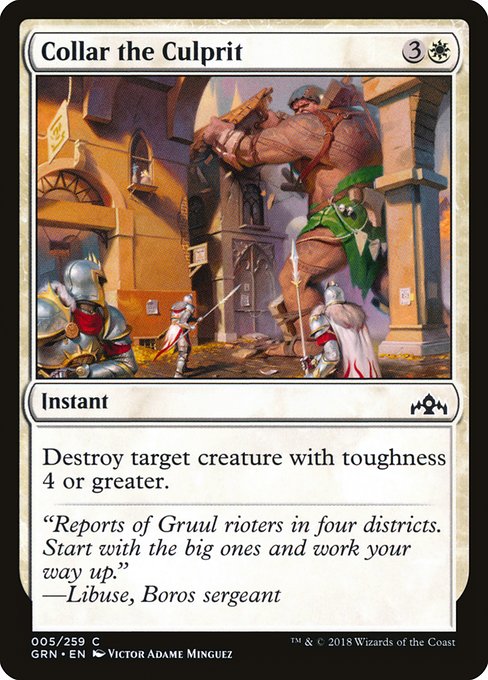
Image courtesy of Scryfall.com
Unusual Planeswalker Interactions Explained
Planeswalkers are the marquee cards in MTG, offering loyalty engines, unique build-arounds, and the constant pressure of a ticking ultimate. But even the most iconic walkers can be brought to their knees by well-timed removal that disrupts the battlefield rather than directly targeting the walker itself 🧙♂️🔥. Collar the Culprit, a compact white instant from Guilds of Ravnica, embodies this idea: destroy target creature with toughness 4 or greater. No direct walker-destroy, no flashy exile—just clean, surgical removal that reshapes how a planeswalker sees the board. In many games, the difference between a walker sitting pretty and a walker facing a lethal punch is a single timely strike. 💎
To appreciate Collar the Culprit, you first need to understand what it does and what it doesn’t. For {3}{W}, you pick a creature with four or more toughness and destroy it. That means a 4/4, 5/6, or any bigger frontline threat is fair game, while a planeswalker or a 3/3 token is not. The card’s strength is therefore situational adaptability: in a meta crowded with big blockers, this instant can clear the path to pressure, threatens the backside of a board, and punishes opponents who rely on stubborn bodies to keep their walkers safe. The flavor text—“Reports of Gruul rioters in four districts. Start with the big ones and work your way up.” — Libuse, Boros sergeant—reads like an affectionately brutal playbook for prioritizing the most formidable threats first. 🧨
Unpacking the planeswalker angle, Collar the Culprit becomes a stealthy accelerator in certain draw-go or midrange matchups. A common plan is to topple a critical blocker that would otherwise prevent your creatures from attacking a walker. If your opponent has a big defender that neutralizes a key attacker or stalls a fight around a walker’s loyalty counters, removing that blocker with Collar the Culprit flips the tempo. Suddenly the planeswalker can be pushed toward its own threats or forced into awkward blocks on your turn, trading a big standing army for a walker’s loyalty swing. It’s tempo-leaning control with a white heartbeat—and it feels deliciously old-school in this era of omnipresent walkers 🧙♂️⚔️.
White removal often shines most when paired with robust board presence and careful timing. In practice, the best plays with Collar the Culprit tend to look like this: you wait for the moment when a 4+ toughness blocker is exactly what your opponent needs to keep a planeswalker safe or to blunt a decisive attack. By removing the blocker, you expose the walker to further pressure or open up lines of attack that didn’t exist one turn before. You’re not just killing a creature; you’re shaping the battlefield so your planeswalker can claim the initiative in the next turn cycle. It’s a quiet victory that rewards patience, planning, and a keen sense for the guardians on the other side of the table 🧙♂️🎲.
Practical play and deck-building notes
From a deck-building perspective, Collar the Culprit rewards a thoughtful white shell that values efficient removal and resilient board presence. It slots nicely into midrange and control-oriented builds where you want to keep a stable curve while gradually eroding the opponent’s defenses. In standard or open formats where 4+ toughness threats are common—think massive greens, seasoned soldiers, or heavily equipped brutes—the spell becomes a reliable answer that preserves your life total and maintains the pressure on the walker’s loyalty pool. And yes, the card’s accessibility as a common makes it a dependable pick for budget-conscious players who still crave meaningful removal with real consequence. 🎨
- Timing matters: play Collar the Culprit when you have a clear target that would otherwise stand in the way of your plan to pressure or attack a planeswalker.
- Target the right threat: prioritize blockers that enable a walker’s defense or that represent a significant swing if left unchecked.
- Support with broader removal suite: combine this instant with other options to cover a wider range of threats and to maintain tempo across turns.
- Commander-friendly: in EDH, large blockers and planeswalker-based boards are common; this spell offers a reliable toolkit to keep walkers honest and pressure thick.
The art by Victor Adame Minguez captures a moment of decisive command that sits perfectly with the Guilds of Ravnica flavor. The image—and the accompanying lore about Gruul upheaval—reminds us that even a disciplined knight of the Boros needs to know when to let the big hammer drop. Collar the Culprit embodies that decisive moment when you trade a single removal for a larger strategic payoff, and in the process you redefine a walker’s trajectory on the battlefield 🧨🎨.
“Reports of Gruul rioters in four districts. Start with the big ones and work your way up.” — Libuse, Boros sergeant
In the end, Collar the Culprit teaches a core MTG lesson with elegant clarity: sometimes the best way to deal with a planeswalker isn’t to target it directly, but to remove the very creature that keeps the walker safe or symbiotic with its support. It’s a reminder that color identity, tempo, and board state still rule the day—even in battles that hinge on loyalty and legendary plans. As you sail the multiverse, this small white instant stands as a quiet testament to the power of precise, context-driven removal 🧙♂️🔥💎.
phone case with card holder magsafe polycarbonate matte glossImage courtesy of Scryfall.com
More from our network
- https://blog.digital-vault.xyz/blog/post/towering-thunderfist-in-silver-border-tourneys-strategy-spotlight/
- https://blog.digital-vault.xyz/blog/post/designing-life-goal-planning-dashboards-for-clarity-and-progress/
- https://blog.digital-vault.xyz/blog/post/lotleth-giant-protection-and-evasion-tactics-for-mtg/
- https://crypto-acolytes.xyz/blog/post/how-to-craft-legendary-items-in-open-world-games/
- https://blog.digital-vault.xyz/blog/post/sphinx-of-enlightenment-typography-and-card-layout-deep-dive/